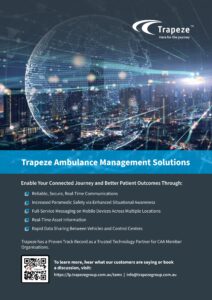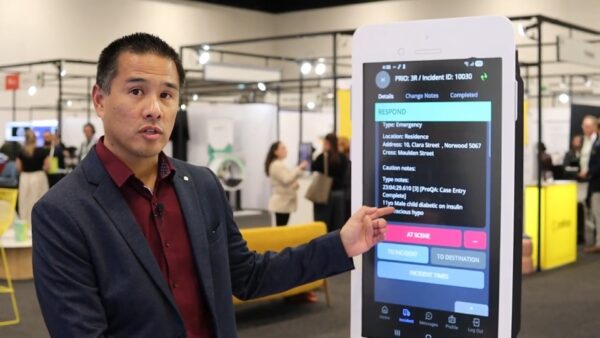This article first appeared in the Council of Ambulance Authorities magazine, First, in December 2020.
As part of the CAA x Corvanta Interactive Ideas Board, two passes to the CAA 2021 Congress were given away to two chosen winners from idea submissions. The winners were Lynden Ferguson of Ambulance Tasmania and Byron Williams of St John New Zealand.
We asked them to expand on their ideas for us, you can read these below.
Lynden Fergusen - Manager, Ambulance Tasmania
Lynden led the Northern Region in the COVID Emergency (first wave). Commenced in Northern Territory for St John Ambulance in 2000 and has served in Ambulance Tasmania since 2002.
According to the Dictionary, an invention is something that has never been made or used before whereas an innovation is an improvement or alteration to an existing idea. With the advent of Coronavirus, health services across the world faced new and old problems that innovative digital solutions can assist in, namely bed allocation and the delivery of critical medical equipment.
It is important to highlight that many sectors incorrectly refer to their digital solutions as “digital platforms”, when really they are stand-alone software programs that are often resistant to integration.
A true digital platform integrates, links or accommodates software programs, allowing the tools to grow and be adapted as an organisation changes. The challenge for hospitals and ambulance services alike is collaboratively pursuing a platform, where integration of software is possible in managing patient flow, visibility of resources and bed allocation in the pandemic environment.
The following are the key points that was submitted to the CAA Corvanta Ideas board that desires to benefit future ambulance service technologies. Many thanks to CAA and Corvanta for this opportunity and I thank them for their contribution to our industry.
A digital pandemic health services platform that maps a state or territory’s available hospital beds and essential medical equipment to support decision makers in the coordination of care. Beds from all health facilities would be classified according to the available level of care, the facilities capacity and if assigned as COVID or NON-COVID patients.
Key features for the platform:
- Hospital and facility bed tracking across a region and/or states, that can be populated, filtered and sorted E.g. Emergency departments, intensive care units, metropolitan, and regional health facilities.
- Identification of health sites and individual wards that could be assigned as COVID and NON COVID in a pandemic working environment to assist incoordination and managing extreme demand.
- A shared and common operating platform for use across all Emergency Operational Centres, hospitals and ambulance communication centres.
- Secure cloud access for real-time updates and visibility.
- At each bed location, a function to highlight and track what key pieces of medical equipment such as ventilators, defibrillators and advanced clinical care services are supported bedside.
- Tracking of inventory medical equipment to support care and medical supplies to enable deployment across regions, states and territories.
- Ability to create algorithms and future demand projections for decision makers. Metric triggers could include the use of AUSMAT, the military, volunteer organisations and when interstate support is required. The projections could also be utilised in a training and simulation environment.
- Hosts interagency arrangements for the sharing of beds and equipment between the states and hospitals.
- Track all mobile medical units and emergency management cache units that carry advanced care equipment such as ECMO, HEMS, Fixed wing, ICP and Retrieval services. This is to support a regions emergency management activity, whether it is a deployment to a nursing home, tent city, makeshift ward or rural hospital.
- Ability to assign and confirm completed action items to approved users on the platform.
- Use in the non-pandemic environment to meet and monitor hospital demand.
Please note that these are the personal views of the writer.
Byron Williams - Clinical Support Officer, St John, New Zealand
Byron has worked in the ambulance sector since 2008 and has a passion for education and ongoing improvement of clinical skills, including communication, crew resource management and holistic ethical management of high-risk vulnerable patients. He sits on the national vulnerable persons review group for St John and has led a range of projects for ambulance clinicians, which integrate high quality holistic teaching into everyday practice.
‘Have a sector of specially trained ambulance officers working on a clinical desk specially assigned to managing vulnerable patients. This would allow operations crews to both call in for advice and also refer patients to the trained officer who can refer the patient onto appropriate end agencies e.g. elder abuse organisations, oranga tamariki (child youth and family), social workers, police family harm teams or specialist COVID response agencies.’ – Interactive Ideas Board Submission
It is well known that the COVID-19 pandemic has caused global disruption, and with this, an increase in family harm and domestic violence. The New Zealand Police have commented in media statements that family harm and domestic violence callouts had an alarmingly high increase when New Zealand went into level 4 lockdown. Over the lockdown and in the months following, St John New Zealand has also noted an increase in vulnerable persons referrals made by operational staff.
Despite the increase in reporting through police and ambulance, it was noted that reports of concern to Oranga Tamariki (formerly known as Child Youth and Family) decreased in the same time period. Suggestions have been made that this is because at risk children are in lockdown, and therefore not around members of society, such as school teachers or childcare providers who would normally recognize when a child is at risk of harm or vulnerability.
This decrease in visibility is not isolated to children, but also extends to the elderly. Many healthcare services that would normally assist elderly in their own homes, suspended or reduced the in-home support they normally provide. This resulted in some elderly not being able to access social support, care and essential services that they normally require, with some being left without food and basic care they require for activities of daily living.
These are only a few of the social challenges that have been noted as a result of the COVID-19 pandemic.
Throughout COVID-19, paramedics have continued to attend calls in people’s homes in the community. Paramedics are in a unique position where they are still invited into people’s home environments, to both assess and treat a patient in their time of need, regardless of the presence of COVID-19. Fortunately, this invitation into people’s homes allows Paramedics the ability to
obtain key information that may identify signs of abuse, neglect, or at-risk environments.
Furthermore, paramedics are often the only healthcare workers that assess patients who refuse further care or are not transported to a medical or other facility for further care. In a lockdown environment, isolation is increased, and so too is the privilege of being invited into people’s homes. However, with that privilege, comes an ethical and legal responsibility of being able to provide assistance when vulnerability or harm is identified.
In normal day to day clinical practice, social presentations to ambulance clinicians – particularly those where people are vulnerable or at risk of harm – can be complex and challenging to manage. When this is combined with the complexities of lockdown, it could be suggested that these challenges are amplified.
With this came the idea of ambulance crews having a specialised person available to contact and discuss concerning cases on a vulnerable person’s clinical desk.
The clinical desk assigned to managing vulnerable patients would give ambulance crews the ability to call for specialised social advice on managing vulnerable patients, as well as providing a referral mechanism for ambulance crews to refer patients to appropriate agencies such as elder abuse organisations, Oranga Tamariki, social workers, Police family harm teams or specialized COVID-19 response agencies. In addition, the vulnerable person’s clinical desk would have the ability to keep up-to-date on the response capabilities of external agencies to make sure patients will be supported in an appropriate manner throughout lockdown restrictions.
It is thought that by providing a single point of call for clinicians to discuss cases of vulnerability in the community, there will be an increase in referrals, and more people who are at risk of vulnerability and family harm in the community will receive help before harm occurs.








